2015 | OriginalPaper | Buchkapitel
Saliency Aggregation: Does Unity Make Strength?
verfasst von : Olivier Le Meur, Zhi Liu
Erschienen in: Computer Vision -- ACCV 2014
Aktivieren Sie unsere intelligente Suche, um passende Fachinhalte oder Patente zu finden.
Wählen Sie Textabschnitte aus um mit Künstlicher Intelligenz passenden Patente zu finden. powered by
Markieren Sie Textabschnitte, um KI-gestützt weitere passende Inhalte zu finden. powered by
